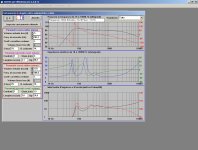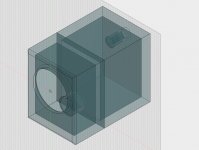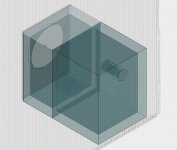Hi all,
I have several FaitalPro 3FE20 8Ohm drivers I'd like to use to build a Double Bass Reflex (DBR), aka DCAAV enclosure. These designs don't seem to be very popular as there aren't a lot of threads discussing DBR enclosures. For those not familiar with the DBR layout, see image. Note it only has two ports, not to be confused with Double Chamber Reflex (DCR) enclosures which have three ports.
I have built these DBR speakers and they sound great: costruzione
However, those speakers are designer for the HiVi B3n driver. I'd like to build a DBR enclosure optimized for the FaitalPro 3FE20.
The FaitalPro 3FE20 fs is only 110Hz. I wasn't aware you could tune an enclosure below the resonant frequency until I came across XRK971's post for the same driver: http://www.diyaudio.com/forums/full-range/293116-help-building-tiny-inexpensive-full-range-computer-speaker-please.html#post4751045 Also, I noticed another small bass-reflex design by Fostex with an Fs of 115Hz is tuned to 92Hz: Fostex FF85WK
My goal for the 3FE20 is a DBR enclosure with and F3 of 80Hz, if possible. Unfortunately, math and simulating are not my strengths. I made the previously mentioned enclosures out of wood, but am considering 3D printing optimized enclosures.
Anyone interested in helping me determine the chamber volumes and dimensions of the ports?
I have several FaitalPro 3FE20 8Ohm drivers I'd like to use to build a Double Bass Reflex (DBR), aka DCAAV enclosure. These designs don't seem to be very popular as there aren't a lot of threads discussing DBR enclosures. For those not familiar with the DBR layout, see image. Note it only has two ports, not to be confused with Double Chamber Reflex (DCR) enclosures which have three ports.
An externally hosted image should be here but it was not working when we last tested it.
I have built these DBR speakers and they sound great: costruzione
However, those speakers are designer for the HiVi B3n driver. I'd like to build a DBR enclosure optimized for the FaitalPro 3FE20.
The FaitalPro 3FE20 fs is only 110Hz. I wasn't aware you could tune an enclosure below the resonant frequency until I came across XRK971's post for the same driver: http://www.diyaudio.com/forums/full-range/293116-help-building-tiny-inexpensive-full-range-computer-speaker-please.html#post4751045 Also, I noticed another small bass-reflex design by Fostex with an Fs of 115Hz is tuned to 92Hz: Fostex FF85WK
My goal for the 3FE20 is a DBR enclosure with and F3 of 80Hz, if possible. Unfortunately, math and simulating are not my strengths. I made the previously mentioned enclosures out of wood, but am considering 3D printing optimized enclosures.
Anyone interested in helping me determine the chamber volumes and dimensions of the ports?
I measured the parameters of a brand new 3FE20 with a Dayton WT3 using the added mass method. If I need to break the driver in for accurate measurement, let me know. I have about a dozen of them. Should measure all of them and average the parameters?
Measurements:
D 62.6 [mm]
Re 6.09 [Ohms]
Fs 128.50 [Hz]
Zm 57.33 [Ohms]
BL 4.39 [N/A]
Qms 5.117
Qes 0.608
Qts 0.543
Vas 0.855 [liters]
L10k 0.37 [mH]
n0 0.28 [%]
dBSPL 86.64 [1W/1m]
Ms 2.38 [grams]
Cms 0.64 [mm/N]
Measurements:
D 62.6 [mm]
Re 6.09 [Ohms]
Fs 128.50 [Hz]
Zm 57.33 [Ohms]
BL 4.39 [N/A]
Qms 5.117
Qes 0.608
Qts 0.543
Vas 0.855 [liters]
L10k 0.37 [mH]
n0 0.28 [%]
dBSPL 86.64 [1W/1m]
Ms 2.38 [grams]
Cms 0.64 [mm/N]
DBR enclosure has no advantage over conventional bass-reflex enclosure, in respect of F3 (and everything else).I'd like to build a DBR enclosure optimized for the FaitalPro 3FE20.
The FaitalPro 3FE20 fs is only 110Hz. I wasn't aware you could tune an enclosure below the resonant frequency
Every driver can be tuned below it's resonant frequency, especially if Qts>0.4
DBR enclosure has no advantage over conventional bass-reflex enclosure, in respect of F3 (and everything else).
Yes, no advantage for F3. From the little I could find on DBR enclosures, some mention an advantage of less cone excursion for the two lowest octaves, while a bass-reflex only reduces excursion for the lowest octave. This should reduce distortion and as the 3FE20 has low x-max, the DBR isn't a bad idea. It is also suggested dividing the enclosure into two small enclosures reduces resonances. Perhaps these enclosures are so small there are no significant audible resonances. If these advantages indeed exist, it is likely at the compromise of other variables.
Every driver can be tuned below it's resonant frequency, especially if Qts>0.4
Thanks! I have much to learn 😉
Mr.Loddie,
How is the sound quality of DBR boxes comparing to regular BR?
.
How to calc a DBR enclousure?
.
Do all FR drivers are suited to DBR?
.
I like this DBR idea, its very useful to use a small VAS driver in a floorstanding enclosure.
Thanks for sharing;
How is the sound quality of DBR boxes comparing to regular BR?
.
How to calc a DBR enclousure?
.
Do all FR drivers are suited to DBR?
.
I like this DBR idea, its very useful to use a small VAS driver in a floorstanding enclosure.
Thanks for sharing;
Claudio,
Thank-you for the simulation! It looks as though the software you have specifically simulates DBR enclosures. I recall reading about Italian software (only DOS compatible?) on one of the DBR threads.
So it looks as though I need to model:
Driver enclosure volume: 0.5L
"External" enclosure volume: 1.01L
Internal port ID: 30mm
Internal port length: 31mm
External port ID: 15mm
External port length: 38mm
Seems simple enough. I'll try design a model today and 3D print it for measurements. Stay tuned...
Thank-you again for taking time to do this! Most appreciated 🙂
Thank-you for the simulation! It looks as though the software you have specifically simulates DBR enclosures. I recall reading about Italian software (only DOS compatible?) on one of the DBR threads.
So it looks as though I need to model:
Driver enclosure volume: 0.5L
"External" enclosure volume: 1.01L
Internal port ID: 30mm
Internal port length: 31mm
External port ID: 15mm
External port length: 38mm
Seems simple enough. I'll try design a model today and 3D print it for measurements. Stay tuned...
Thank-you again for taking time to do this! Most appreciated 🙂
Take a look at simulation claudio kindly shares with us. DBR enclosure has less excursion only at 350 Hz, not "two lowest octaves". And there is a dip in frequency response at 350 Hz to penalize that.From the little I could find on DBR enclosures, some mention an advantage of less cone excursion for the two lowest octaves, while a bass-reflex only reduces excursion for the lowest octave.
Mr.Loddie,
How is the sound quality of DBR boxes comparing to regular BR?
.
How to calc a DBR enclousure?
.
Do all FR drivers are suited to DBR?
.
I like this DBR idea, its very useful to use a small VAS driver in a floorstanding enclosure.
Thanks for sharing;
Hi FullRangeMan,
I'm not more an expert on DBR than you. Unfortunately I don't know how to calculate a DBR enclosure. I'm better at making things than math. From the threads I could find, there are few programs that are capable, including the software Claudio has, DCBOXMODEL (DOS only, if you can find it), LspCAD, Akabak, and Martin J. King's Matched worksheets (perhaps no longer available?).
As for the sound, other than lack of bass, it is very impressive with the Faital 3FE20 for such as small speaker. I also have Danley Unity horns, but they aren't current set up for a direct comparison.
FWIW, I've also built the Hilding horns and in direct comparison with the DBRs, I preferred the DBRs. The DBR is also much smaller than the Hilding horn. This is important for me as I'd like to use the DBRs for convoluted surround ambiance channels (music) and Dolby Atmos/DTS:X ceiling speakers (home theater).
With they aren't as easy to build as a bass reflex, I built a pair of DBRs in just a few hours with simple tools. The hardest part was finding tubing for the ports with the correct internal diameter (ID), but I had scraps that were within a mm.
Hope this helps...
Take a look at simulation claudio kindly shares with us. DBR enclosure has less excursion only at 350 Hz, not "two lowest octaves". And there is a dip in frequency response at 350 Hz to penalize that.
Hi Sonce,
Thanks for pointing this out. To be fair, other threads have pointed out the dip in response as a disadvantage to DBR.
It will be interesting to see how deep the dip actually measures.
If you want to simulate a bass-reflex so I have the volume and port dimensions, I could 3D print it as well for a blind A-B comparison with Claudio's DBR (speakers will be behind theater screen and my wife can control the switch) 😀
Thanks!
Last edited:
Don't worry too much to the frequency dip, it's less audible than you can imagine. Pay attention at cabinet leaks, which can change the final response much more than what happens in a reflex speaker. Try to keep at minimum the absorving mat in the high chamber (the one with the woofer), and possibly don't use any in the low one (DBR it's a series resonance system, and the lower chamber efficiency depends on how much energy arrives to it).
Also try to place the 2 ports not too close to each other.
The software I used is called Audio for Windows, it's only in italian, and is available through the italian magazine Audioreview.
Also try to place the 2 ports not too close to each other.
The software I used is called Audio for Windows, it's only in italian, and is available through the italian magazine Audioreview.
Claudio, Thanks for the tips!
Here is a CAD mockup with the volumes and port dimensions based on Claudio's simulation.
I filleted the rear (external) port slightly (see rear image). Does anyone know how to compensate port length if you fillet or flat the port ends? If not, I'll start printing it soon.
Also, other than volume, does it matter if the internal port extends into the rear enclosure volume? I modeled the port extending into the front enclosure, but am curious.
Here is a CAD mockup with the volumes and port dimensions based on Claudio's simulation.
I filleted the rear (external) port slightly (see rear image). Does anyone know how to compensate port length if you fillet or flat the port ends? If not, I'll start printing it soon.
Also, other than volume, does it matter if the internal port extends into the rear enclosure volume? I modeled the port extending into the front enclosure, but am curious.
Attachments
Also, other than volume, does it matter if the internal port extends into the rear enclosure volume? I modeled the port extending into the front enclosure, but am curious.
In my experience, not really. It might help to place it in the middle if the port is too close to the driver. You can experiment yourself, measuring the impedance and paying attention at spikes in the curve. 😉
OK, thanks!
I just realized I may have done my volume calculations wrong. I did model the driver to account for its volume (not shown). However, I didn't account for the ports.
When calculating enclosure volume, do you subtract the entire volume of the port (air and tubing) or just the port (tubing only)?
I just realized I may have done my volume calculations wrong. I did model the driver to account for its volume (not shown). However, I didn't account for the ports.
When calculating enclosure volume, do you subtract the entire volume of the port (air and tubing) or just the port (tubing only)?
You have to subtract the port volume (it's a cylinder).
Also subtract the driver's back volume (frame + cone + magnet).
Also subtract the driver's back volume (frame + cone + magnet).
- Status
- Not open for further replies.
- Home
- Loudspeakers
- Full Range
- Full range Double Bass Reflex (DBR) w/FaitalPro 3FE20


